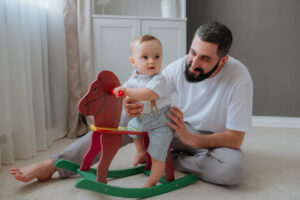Why Do Babies Have More Bones Than Adults?
Babies are born with more bones than adults, and the number of bones decreases as they grow. This phenomenon is primarily due to the presence of cartilage in the baby’s body and the process of ossification, which is the transformation of cartilage into bone. Here are the key reasons why babies have more bones than adults:
1. Cartilage Structure:
– At birth, a baby’s skeleton is largely made up of cartilage, a flexible and elastic connective tissue. Cartilage is present in areas where bones will eventually form.
– The cartilage serves as a template for the future development of bones.
2. Ossification Process:
-This process occurs over time as the baby grows and develops.
– Some bones start as separate pieces of cartilage that eventually fuse together as ossification progresses.
3. Fontanelles and Soft Spots:
– Babies have fontanelles, also known as soft spots, on their skulls. These are areas where the bones are not fully formed, and they allow for the flexibility needed during childbirth.
– The fontanelles eventually close as the bones of the skull fuse together.
4. Growth and Fusion:
– As a baby grows, the number of bones decreases due to the fusion of adjacent bones. This fusion process occurs through childhood and adolescence.
– The fusion results in the formation of larger and more stable bones.
5. Adaptation to Movement:
– Babies need a more flexible skeleton to accommodate their rapid growth and movement during early development.
– Having more bones allows for greater flexibility, making it easier for babies to navigate their environment.
6. Functional Changes:
– Some bones present in a baby’s body serve specific functions during infancy and childhood but are not needed in the same form in adulthood. As a result, these bones may fuse or undergo changes.
By the time a person reaches adulthood, most of the cartilage has been replaced by bone, and the number of bones has decreased through fusion. The adult human skeleton typically consists of 206 bones, although the exact number can vary slightly from person to person due to differences in bone fusion. Understanding the process of bone development helps explain why babies start with more bones, and it highlights the dynamic nature of the human skeletal system as it adapts to growth and functional needs.

How Many Bones Does a Baby Have When Born?
A human baby is born with approximately 270 bones. However, this number can vary slightly from one individual to another. The reason babies have more bones than adults is due to the presence of soft spots, or fontanelles, on their skulls and the fact that some of the bones have not yet fused together.
As a baby grows, the process of ossification takes place. Ossification involves the transformation of cartilage into bone and the fusion of certain bones. Over time, as the baby develops, some of the bones fuse together, resulting in a decrease in the total number of bones. By the time an individual reaches adulthood, the typical human skeleton consists of 206 bones.
How Do My Baby’s Bones Grow?
The growth of a baby’s bones involves a complex process known as ossification, which is the formation of bone tissue. Here’s a brief overview of how your baby’s bones grow:
1. Cartilage Formation:
– Before bones develop, a baby’s skeleton is initially made up of cartilage. Cartilage is a flexible and elastic connective tissue that serves as a template for bone formation.
2. Primary Ossification:
– The first stage of bone development involves the conversion of cartilage into bone tissue. This process is called primary ossification.
– Ossification centers form in the cartilage, and minerals, such as calcium and phosphorus, are deposited to harden the tissue and create bone.
3. Growth Plates:
– At the ends of long bones, there are areas called growth plates (or epiphyseal plates). These plates consist of cartilage cells that actively divide and contribute to bone lengthening.
– As the baby grows, these growth plates are responsible for the longitudinal growth of bones.
4. Secondary Ossification:
– In addition to the primary ossification centers, secondary ossification centers develop in certain bones after birth. These centers contribute to the growth and development of specific bone regions.
5. Bone Remodeling:
– Throughout childhood and adolescence, bones undergo a continual process of remodeling. This involves the removal of old bone tissue and the formation of new bone tissue.
– Bone remodeling is influenced by factors such as hormonal changes, mechanical stress (from physical activity), and nutritional factors.
6. Fusion of Bones:
– As a child grows, some bones initially exist as separate pieces connected by cartilage. Over time, these bones fuse together through a process called bone fusion.
– The fusion of bones reduces the overall number of bones in the skeleton as the individual matures.
7. Maturation of Growth Plates:
– During adolescence, the growth plates in long bones gradually close as the cartilage cells stop dividing.
8. Adult Skeleton:
– By the time an individual reaches adulthood, most of the cartilage has been replaced by bone, and the majority of bones have undergone fusion.
The growth of a baby’s bones is a dynamic and intricate process that involves a combination of genetic, hormonal, nutritional, and environmental factors. Adequate nutrition, including sufficient intake of calcium and vitamin D, is crucial for proper bone development. Regular physical activity also plays a role in promoting healthy bone growth and density.
The growth of a child’s bones is a gradual process that occurs over several years. The timeline for bone growth and development can vary from person to person, and it is influenced by factors such as genetics, nutrition, hormonal balance, and overall health. The key stages in bone growth include infancy, childhood, and adolescence. Here are some general milestones:
1. Infancy:
– Rapid bone growth occurs during infancy, particularly in the first two years of life.
– Fontanelles (soft spots on the skull) close, and the bones continue to ossify and develop.
2. Childhood:
– Bone growth continues throughout childhood, with significant growth occurring in long bones.
– Growth plates, located at the ends of long bones, contribute to the lengthening of bones.
3. Adolescence:
– The most rapid phase of bone growth typically occurs during adolescence, often referred to as the pubertal growth spurt.
– Growth plates actively contribute to longitudinal bone growth during this period.
4. Growth Plate Closure:
– Toward the end of adolescence, growth plates close. Once the growth plates close, longitudinal bone growth ceases.
– The closure of growth plates is a crucial indicator that a person has reached skeletal maturity.
5. Late Teens to Early 20s:
– While longitudinal bone growth stops with the closure of growth plates, bone density continues to increase during late adolescence and early adulthood.
– Bone density reaches its peak in the mid-20s, after which it tends to stabilize.
It’s important to note that individual variations exist, and some people may reach skeletal maturity earlier or later than the average timeline. Additionally, bone health is influenced by lifestyle factors, including nutrition, physical activity, and overall health. Adequate intake of calcium, vitamin D, and other nutrients is essential for supporting healthy bone development.
While bones stop growing in length after growth plate closure, bones continue to undergo remodeling throughout life. Bone remodeling involves the removal of old bone tissue and the formation of new bone tissue, maintaining bone strength and integrity. Regular weight-bearing exercise and a balanced diet contribute to overall bone health even after the growth phase is complete.
Keeping Your Child’s Bones Healthy
Maintaining healthy bones in children is essential for their growth, development, and long-term well-being. Here are some guidelines to help keep your child’s bones healthy:
1. Nutritious Diet:
– Ensure your child receives a well-balanced diet that includes calcium, vitamin D, and other essential nutrients for bone health.
– Good sources of calcium include dairy products, leafy green vegetables, fortified foods, and certain types of fish.
– Vitamin D, crucial for calcium absorption, can be obtained from sunlight exposure and dietary sources like fatty fish, fortified foods, and supplements if necessary.
2. Physical Activity:
– Encourage regular physical activity, including weight-bearing exercises like running, jumping, and sports activities.
– Physical activity helps build strong bones and improves overall bone density.
3. Limit Sedentary Behavior:
– Minimize sedentary activities, such as excessive screen time and sitting for long periods. Engage your child in active play and recreational activities.
4. Safety Measures:
– Promote safety during play and physical activities to prevent fractures or injuries.
– Provide proper protective gear for activities like biking, skating, and sports.
5. Regular Checkups:
– Schedule regular checkups with a pediatrician to monitor your child’s growth and development.
– Address any concerns about bone health or development with the healthcare provider.
6. Adequate Sleep:
– Ensure your child gets sufficient sleep, as sleep is essential for overall growth and development, including bone health.
7. Limit Soda and Caffeine Intake:
– Limit the consumption of sugary drinks, especially those high in phosphoric acid, as excessive phosphoric acid intake may interfere with calcium absorption.
8. Encourage Healthy Habits:
– Promote a healthy lifestyle, including good hygiene, regular handwashing, and avoidance of smoking or exposure to secondhand smoke.
9. Bone Density Testing if Needed:
– In certain cases, especially if there are concerns about bone health, your healthcare provider may recommend bone density testing or other diagnostic measures.
10. Monitor Vitamin Levels:
– Keep an eye on your child’s vitamin levels, particularly vitamin D, and consult with a healthcare professional if there are concerns or if supplementation is necessary.
It’s important to note that building strong bones during childhood lays the foundation for bone health throughout life. Establishing healthy habits early on can contribute to optimal bone development and reduce the risk of bone-related issues in the future. Always consult with healthcare professionals for personalized advice based on your child’s specific needs and health status.


